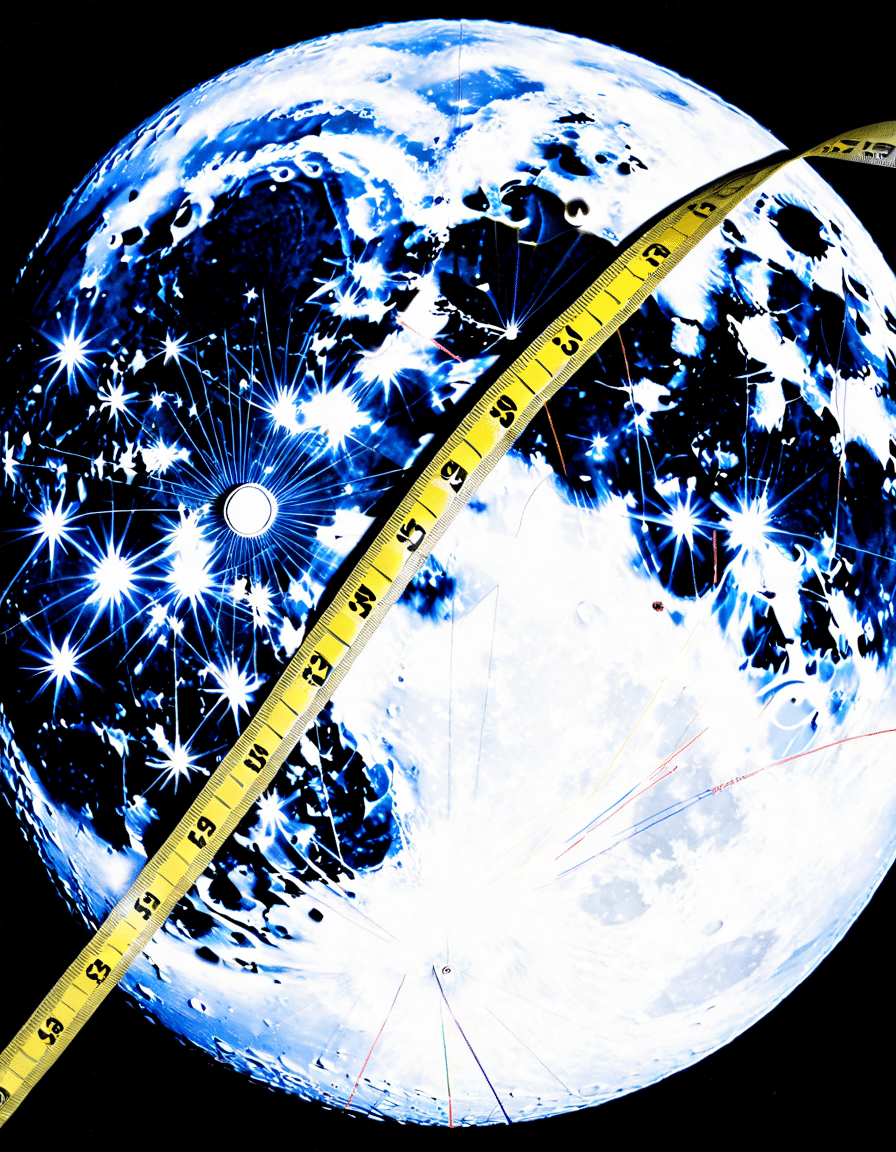When pondering the vastness of space, a common question arises among both enthusiasts and casual observers alike: how far is the Moon from Earth? This distance, measured as an average of 238,855 miles (384,400 kilometers), plays a vital role in our understanding of celestial mechanics, lunar exploration, and even our own planet’s tides. As we delve deeper into the intriguing relationship between Earth and this otherworldly companion, we’ll explore the implications of its distance, alongside fascinating insights into our interactions with the Moon and the universe at large.
## How Far Is The Moon From Earth: 238,855 Miles
The Moon’s orbit isn’t a perfect circle; it’s elliptical. This means the distance from Earth isn’t constant and can vary by around 31,000 miles (50,000 kilometers) throughout its orbit. At its closest, known as perigee, the Moon can be about 225,623 miles away. On the other hand, at its farthest point, called apogee, it stretches to about 252,088 miles, reminding us that even our nearest celestial neighbor isn’t as straightforward as it seems.
The gravitational pull of the Moon isn’t just an intriguing fact; it significantly affects Earth’s tides. The distance between Earth and the Moon is crucial in maintaining the tidal forces that shape our coastlines and influence marine ecosystems. It’s fascinating to realize that this relationship exemplifies the interconnectedness of celestial bodies, reminding us that our daily lives are, in countless ways, impacted by our cosmic neighbor.
The Apollo missions were not just ambitious projects; they exemplified human ingenuity in reaching the Moon, motivated by the fascinating distance of 238,855 miles. Apollo 11, celebrated for landing the first humans on the lunar surface in 1969, showcased that humankind could travel great distances in space. These missions paved the way for subsequent explorations and inspired generations to look up at the night sky with wonder.
Now, you might wonder, how long does it take to get to Mars? But first, let’s consider our Moon. It takes about three days for spacecraft to travel the 238,855 miles to our lunar neighbor. In contrast, reaching Mars can take six to nine months, depending on various factors, including the elliptical orbits of the two planets. This stark difference highlights the challenges of space travel as we stretch beyond our Moon to other planets in the solar system.
Understanding how far the Moon is from Earth is essential for grasping gravitational dynamics. For instance, knowledge of this distance plays a critical role in predicting solar eclipses, like the one that will occur on April 8, 2024. The phenomena depend on precise calculations of distances between the Sun, Earth, and Moon, including predictions of when and where solar eclipses will be visible, reminding us of the spectacular ballet of celestial mechanics.
Throughout history, the Moon has been a source of inspiration for countless myths, legends, and scientific inquiries. Its distance was first measured by ancient astronomers such as Aristarchus of Samos, and in the 20th century, radar technology confirmed these measurements. These endeavors highlight humanity’s quest to understand its place in the universe, weaving together science and storytelling.
As we look ahead, space agencies like NASA and private enterprises are fervently planning new missions to the Moon. Understanding how far the Moon is from Earth remains crucial, especially as initiatives such as the Artemis program aim not only to revisit our lunar neighbor but also to use it as a launchpad for further exploration to Mars and beyond. This ambitious vision is anchored in humanity’s enduring desire to explore and make our mark in the cosmos.

Understanding Celestial Phenomena Beyond the Moon
While the Moon might be our closest celestial body, it prompts numerous inquiries about other astronomical events. For example, what is a solar eclipse? This occurs when the Moon passes directly between the Earth and the Sun, temporarily obscuring the Sun’s light. Solar eclipses only happen during a new moon, and understanding the Moon’s distance is crucial for accurately predicting these stunning celestial events, unveiling magnificent sights that capture our collective imagination.
The curiosity surrounding space extends to debates about significant events here on Earth, such as where did Helene make landfall? This inquiry connects our interest in celestial events with natural phenomena. For instance, Hurricane Helene made landfall on the southeastern coast of the U.S. while the Moon remained a quiet sentinel overhead, urging us to ponder the greater universe’s mysteries.
An Insightful Reflection on Our Cosmic Neighbor
Ultimately, understanding how far the Moon is from Earth, along with the implications of its distance, shapes our perspective on the universe. The Moon, located approximately 238,855 miles away, isn’t just a satellite; it serves as a symbol of exploration, scientific achievement, and our interconnectedness with the cosmos. As we continue to learn more about our solar system, from exploring the Moon’s surface through missions like Apollo to preparing for Mars exploration, we gather information that enriches our understanding of both our celestial neighbors and our planet.
The fascination with the Moon fuels the human spirit of curiosity, perseverance, and an unwavering pursuit of knowledge. Each scientific discovery builds on the previous one, inspiring future generations to reach for the stars and expand humanity’s horizons in ways previously thought impossible. We stand on the cusp of a future that may once again see humanity walking on the Moon or even exploring Mars, fueled by the collective dreams of those who look up at the night sky with wonder.

How Far Is The Moon From Earth
Understanding how far is the moon from Earth isn’t just about numbers; it’s a fascinating journey into the cosmos. At a stunning average distance of 238,855 miles, the moon is more than just a pretty face in our night sky. Did you know that if you drive your car at 60 miles per hour, it would take you a little over six months to reach the moon? Talk about a road trip! Now, if you’re into wildlife, think about visiting the Santa Ana zoo and then imagining how many animals could fit in that vast distance.
The Moon’s Influence on Us
The moon isn’t only about distance; it has a profound impact on Earth. Its gravitational pull creates tides, which play a crucial role in marine ecosystems. Fun trivia for the Marvel fans: just like how the characters in Spider-man : No Way Home navigate through their own challenges, our moon helps stabilize Earth’s tilt, contributing to our climate. Without it, our seasons would be all over the place—much like trying to watch Kari Matchett juggle multiple roles in a thrilling series.
Discovering Space and Time
Now, speaking of time, considering how far is the moon from Earth also means acknowledging our technological advancements. It takes light from the moon about 1.28 seconds to reach us. That’s quicker than your favorite Netflix show technically debuts! Speaking of shows, if you’re into anime, the excitement of waiting for Reincarnated as a Sword Season 2 can give you that same thrill as waiting for a lunar eclipse. And while the moon orbits, it’s fascinating to know that just like the many stories behind Shemar Moore ‘s Movies And TV Shows, each phase of the moon has a tale to tell.
So, whether you’re gazing at the moon or learning about its celestial dance, there’s always something new to discover. The moon, at 238,855 miles, stands as a reminder that our universe is vast and holds countless mysteries—just waiting for us to dive in. Speaking of mysteries, take a moment to ponder the story of steel with Acero, a glimpse into how elements connect to our understanding of everything, even space. And just like history shaped our interactions—like the insights from a Civil War review—the( moon continues to influence our journey on Earth. So, isn’t it thrilling to think about how far is the moon from Earth and the myriad of stories entwined in that journey?




